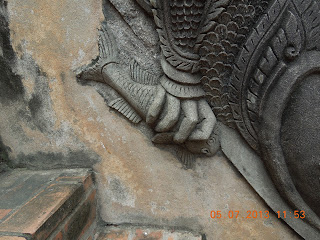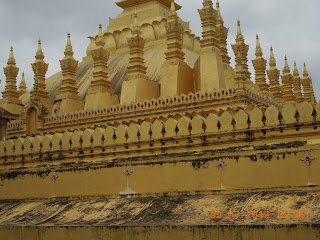Yesterday we met with four Chinese teachers at a National University of Laos who did NOT lecture us because they had not gotten "permission" from the Chinese government go do so; we just chatted for two hours about their being sent to Laos to teach. Their salaries are higher than they are at their university in China because of the hardship of living here and having no air conditioning or internet at the school. China not only sends them but also pays them to do this teaching. This was my favorite teacher, and we talked about my coming over to China to teach English. Just a thought...

This squiggle is at the top of most temples, and our guide told us that it symbolizes the naga, the big snake like creature that represents the Mekong.

Today we went to three temples: the first was Sisaket, built in 1818 out of rosewood. In all of these little niches there are two Buddhas, each of whom must have needed company.

There were scads of Buddhas in this temple, lining the halls and the walls, but I photographed this fellow for my sister because he seemed to have some gum disease... The interesting thing about this temple is the way the pillars were constructed, according to our guide; they used buffalo skin, mud, water and tamarind, and the mixture lasts 800 years while concrete lasts only 60. Good fact, eh?

Here is one of the halls with the lines of Buddhas, all in their little orange scarves to indicate enlightenment.

This is a naga that was used to sanctify the Buddhas, working like a trough where the water moved out of the bottom, dripping onto the heads of the statues. Why, I cannot tell you.

Laos is called the three elephant kingdom because it used to be made up of three kingdoms, Vientienne, Luoang Prabang and Sakonoset. This elephant has three heads and is sprawled over the front and two sides of this edge of a stupa.

We noticed at the temple where the jade Buddha is supposed to be that the nagas all had a fish in their little clawy feet.

A little monk is going up to pay a visit to the temple where the jade Buddha that the Thais took is supposed to be. I forgot the name of it, but then, we HAVE seen loads of temples, and frankly... Okay, I looked it up, and it's called Haphrakeo.

I remember photographing this rather uncomfortable looking Buddha when I was here over 5 years ago; the guy still looks bloated as though he needs Pepto Bismol or at the very least, an enema.

Wat Si Saket is the big Vientienne "sight" that stands out because of its garish golden peaks. It's looking a little shabby if you ask me.

And here is the wonderful Patuxai, also known as Vientienne's Arc de Triumph, a concrete structure that was built with the money AND the concrete that the U.S. had sent to Laos to make an airport; something happened whereby Russia provided the airport, and this is the result of America's dollars. You can walk up the stairs all the way to the top and photograph the prime minister's office, which I did.

Today was "half moon day," a festival in Laos, and these flowers were placed in front of most of the sacred places, including temples AND the Patuxai.

Here is the ceiling of the bottom of the structure, and the figures depicted are from the Ramayana, of all things! Tomorrow we fly to Luoang Prabang where the temperatures will be cooler, I'm sad to say. I loved running along the Mekong River this morning in the gray mist of pre-dawn. They have built an excellent walkway and a road above the river, which is really, really low now, and the walkway runs for about 3 miles.







No comments:
Post a Comment